
Seed Treatment and Inoculation
Agroforestry for the Pacific Technologies
A publication of the Agroforestry Information Service
July 1995, Number 12
To germinate and grow, seeds must absorb water. The seeds of many tree species have waxy or thick “seed coats” that inhibit water absorption and thus delay germination. Seedcoats dissolve slowly in several ways. Exposure to sun, rain and wind dissolves the seedcoat over time. The heat from natural fire cracks the seedcoat. Insects and animals may nibble holes in the seedcoat without damaging the seed embryo. When seeds are consumed by animals, stomach acid weakens the seedcoat. Once passed through the animal, seeds germinate. Under natural conditions the seed crop of one year germinates unevenly over a long period. This uneven germination strategy assures that at least some of the seedlings will survive environmental hazards such as drought, fire, frost or insect or animal attack. Seedlings that germinate early may be well enough established to survive such hazards late in the season, while seedlings that germinate late will avoid early-season problems. Some seeds will remain dormant in the soil for years.
Seed Treatment
In. a nursery or plantation it is easiest to protect seedlings or trees when they are of uniform age and size. Uniform seedling size can be achieved by proper seed treatments before sowing. Seed treatments, which mimic nature, are designed to penetrate the protective seedcoat and allow water to be absorbed. Several seed treatment methods are common:
Cool water – Seeds are soaked in cool, room temperature, water until they swell. The volume of water should be five times the volume of seeds. Soaking time may from 648 hours depending on species, provenance, age and quality of seed. This treatment is appropriate for seeds with a thin or soft seedcoat, recently harvested seed, seed of small size, and large quantities of seed.
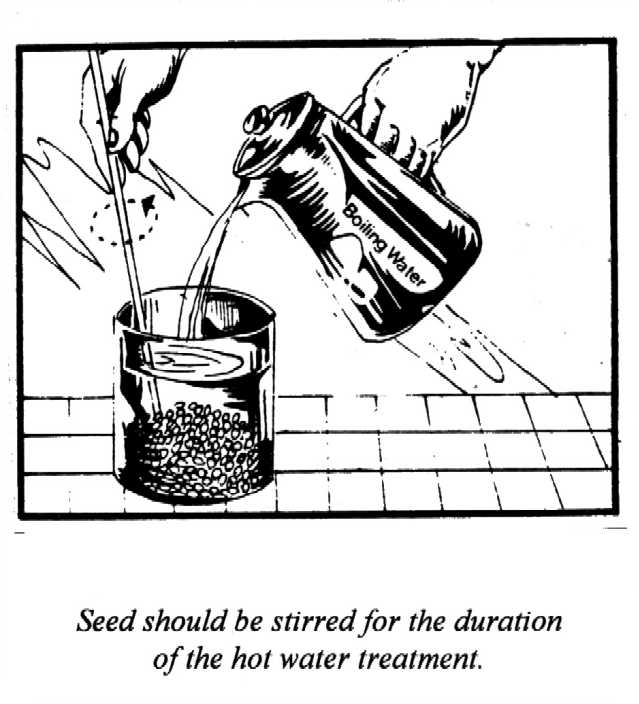
- Hot water – Pour boiling water over the seeds at a volume five times the volume of seeds.
- The seeds must be stirred gently during the 2-5 minute soak. Hot water can kill the seed – it is important not to soak the seed for too long! Pour off the hot water, replace it with cool water and soak for 12 hours. This treatment is appropriate for seeds with hard or thick seedcoats, old seed, and large quantities of seed.
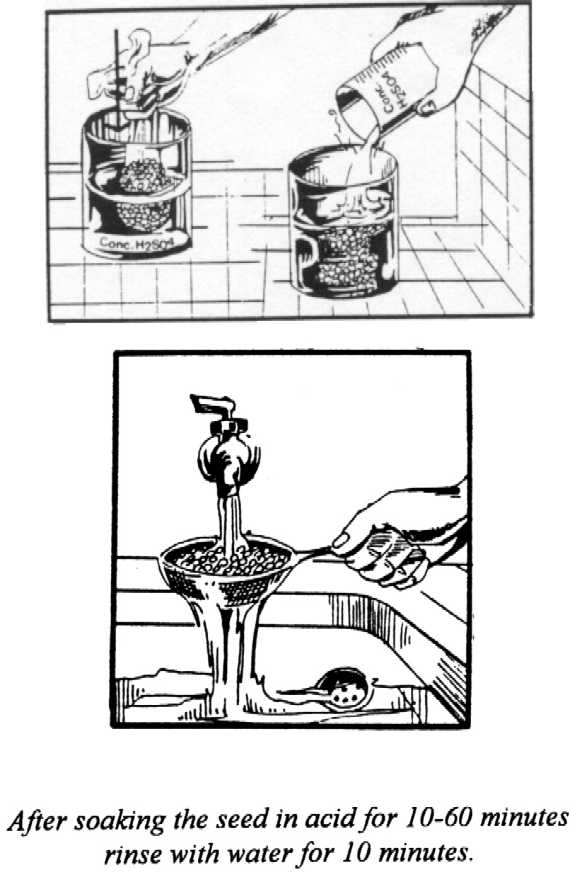
- Acid – Cover seeds with sulfuric acid for 10-60 minutes. Seed should be completely submerged but just below the surface of the acid. Acid can kill the seed – do not soak the seed for too long! Gauge the length of acid treatment by the appearance of the seed. The waxy gloss of the seedcoat should be replaced by a dull appearance. A pitted appearance indicates damage – remove the seeds before this occurs.
- Remove seed from acid, rinse with water for 10 minutes and soak in cool water for 12 hours. Do not pour water into the acid or a violent reaction will occur! The acid can be used several times. This treatment is appropriate for seeds with hard and thick seedcoats. Acid treatment can be dangerous and expensive! In most circumstances it is not recommended!
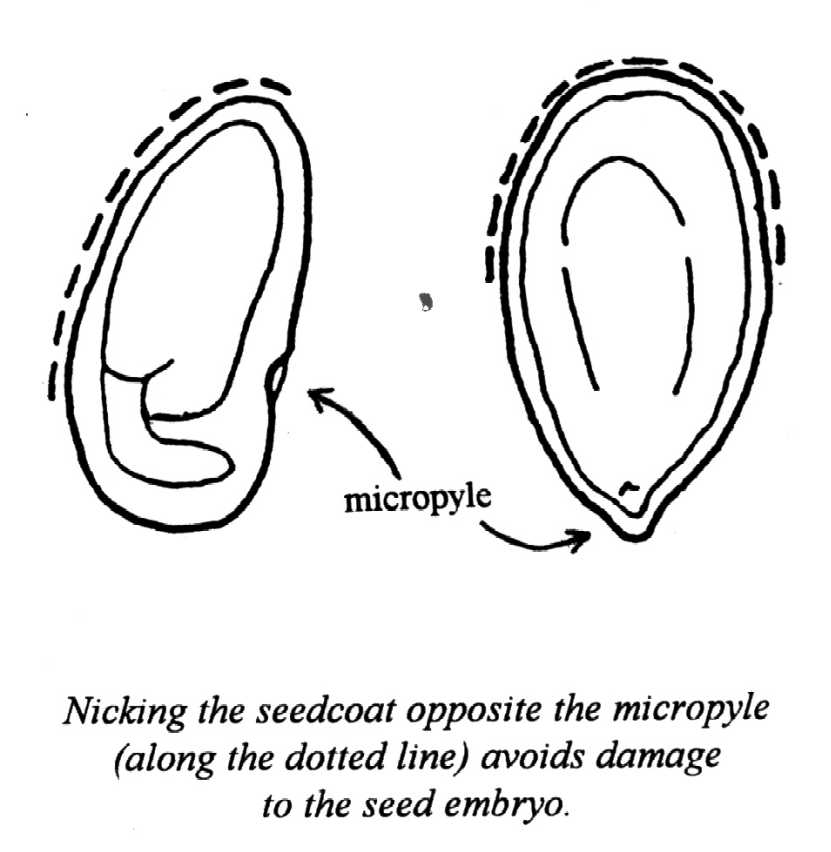
- Nicking – Cut or scrape a small opening in the seedcoat. A knife , nail clipper, metal file, sand paper or sanding block can be used for this operation. To avoid damaging the seed embryo, cut or scrape the seedcoat only opposite the micropyle (the small ring where the seed was formerly attached to the fruit of its mother plant). Nicked seed is soaked in cool water for 12 hours.
- This treatment is appropriate for all types of seeds, with the exception of those that are very small or recalcitrant (having a soft seedcoat and short viability). However, being time consuming, this treatment is feasible only for small quantities of seed.
No treatment – Some seeds germinate quickly without treatment Application of the above methods may be impractical, make seed difficult to handle or decrease viability. No treatment is needed for tiny seed, i.e. Alnus sp. and Casuarina sp.; seeds with thin or incomplete seedcoats: and recalcitrant seed, i.e. Inga sp.
The length of the initial soak in cool water, hot water or acid will vary according to species, provenance, age and quality of the seed. If large numbers of seedlings will be produced, or nursery operations will last for several years, it is recommended that several soaking times be tested in order to determine the most suitable time length for local conditions. As noted, with all methods the last process is to soak seed in cool water for 12 hours. This final process allows seed to absorb water, results in visible swelling and further hastens germination. To improve this process, and thus germination, this period may be increased up to 48 hours. A summary of appropriate seed treatments for select species is listed in Table 1. Once removed from this final soaking the swollen seeds should be sown immediately – do not store treated seed! At this point, follow standard nursery or and plantation procedures (Evans 1982, Jackson 1987, Liegel and Venator 1987). When sowing seeds directly in the field, operations must coincide with the beginning of the rains. Treated seed germinates quickly, and a short dry period will result in high mortality. It is best to wait for the first rain before direct sowing treated seed.
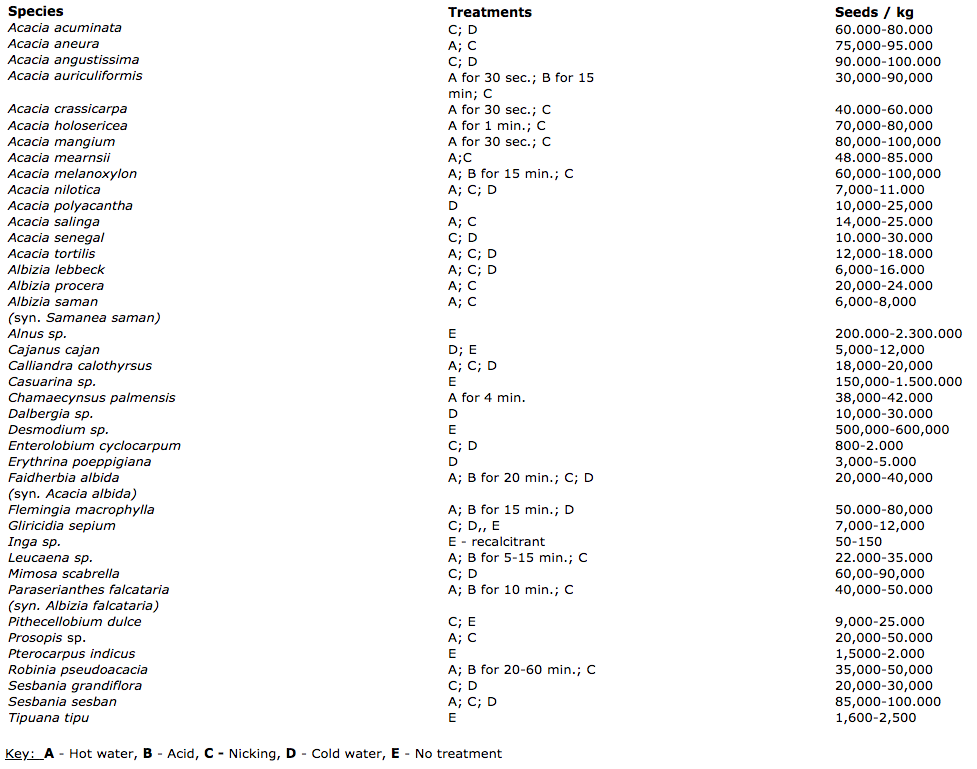
Nitrogen Fixation. Many tree species can transform or “fix” atmospheric nitrogen into a form the tree can use for growth: This allows the “nitrogen fixing tree” (NFT) to grow on degraded soils that are poor in nitrogen. NFTs are common components in farming systems, land reclamation schemes, pasture systems, fallow improvement, home gardens and ornamental plantings. These trees provide valuable timber, fuelwood, poles, fodder, green manure, honey, fruit, vegetables, shade and other products. For further details concerning NFT management systems and products see Macklin (1990).
Nitrogen fixing trees fall into two categories, based on the symbiotic microorganisms which enable nitrogen fixation to occur. Trees in the families Leguminosae and Ulmaceae fix nitrogen with bacteria from the genus Rhizobium. Species from several families – including Betulaceae, Casuarinaceae, Elaeagnaceae, Rhamnaceae, Rosaceae – fix nitrogen with actinomycete bacteria from the genus Frankia (Postgate 1987, NFTA 1989). The most important NFT genera include the legumes Acacia, Albizia, Calliandra, Chamaecytisus, Dalbergia, Erythrina, Flemingia, Gliricidia, Leucaena, Prosopis and Sesbania, as well as, the non-legumes Alnus, Casuarina, Elaeagnus, Hippophae and Robinia. The bacteria form nodules on the roots of the tree, and nitrogen fixation occurs inside these nodules. Healthy nodules that are fixing nitrogen are easy to identify. Cut them open and check their color. Pink or red nodules are fixing nitrogen, while green, black or brown nodules are not.
There are many strains of Rhizobium and Frankia. These bacteria and the NFTs exhibit an exclusive preference for one another. Some Rhizobium will form nodules with some legumes but not others. The same type of preference is shown between Frankia and the non-legumes. A successful match must be made if functioning nodules are to be formed.
In areas where a tree is native or naturalized, the soil will likely contain bacteria of appropriate bacteria strains. If a tree is not common in an area, or the site is degraded, there may not be enough of the correct bacteria in the soil to stimulate nodulation and fixation. It should be noted that Frankia survives in the soil without the presence of the host plant for longer periods than Rhizobium. In any case, it is best to trait seeds or seedlings with the appropriate strain of bacteria to stimulate maximum nitrogen fixation. This process is called inoculation.
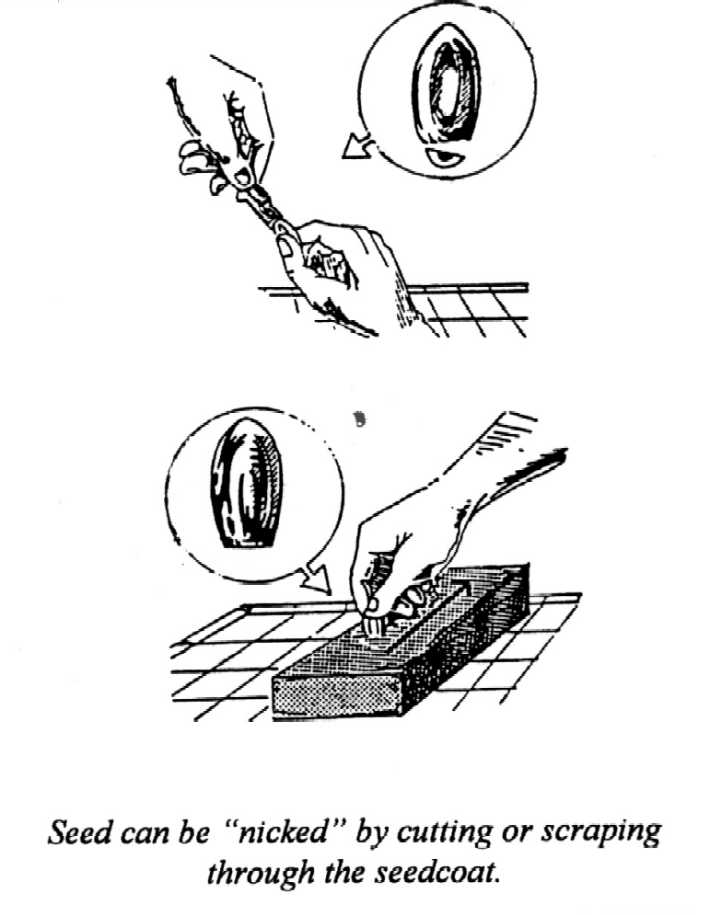 Inoculation
Inoculation
The material used to inoculate seeds or seedlings is produced by isolating bacteria from the root nodules on healthy trees, growing them in a laboratory and mixing them with peat. The peat-based inoculant contains 1000 times the number of bacteria normally found in the soil. The bacteria in inoculants are alive. They are sensitive to heat, drying out and direct sunlight. The inoculant should be tightly sealed and stored in a moist, cool, dark place when not in use. It should not be frozen, as freezing kills the bacteria. The inoculant should be applied to tree seed directly after seed treatment and immediately before sowing. Application of inoculant is most effective when seeds are first covered with a sticker solution. Place seeds in a plastic bag or bucket and cover them with the solution made of gum arabic, sugar or vegetable oil. Either dissolve the 40 g of gum arabic in 100 ml of hot water and allow to cool, or dissolve 1 part sugar in 9 parts water. Combine 2 ml of one of these mixtures, or 2 ml of vegetable oil, with 100 g of seeds and shake or stir until the seeds are well covered. Then add 5 mg of inoculant and shake or stir until the seeds again are well covered. Allow the inoculated seeds to dry for 10 minutes to eliminate any stickiness and sow immediately (Keyser 1990). Do not store inoculated seed – the bacteria will die.
Seedlings can also be inoculated in the nursery after germination. Mix inoculant in cool water and irrigate the seedlings with the suspension. Keep the mixture well shaken and irrigate until the inoculant is washed into the root zone. A 50 g bag of inoculant is sufficient to inoculate 10,000 seedlings (Keyser 1990). For effective inoculation of seeds or seedlings to occur the bacteria in the inoculant must be appropriate for the tree species involved. For information on inoculum availability contact :
Nitrogen Fixation in Tropical Agricultural
Legumes (NifTAL) Center
1000 Holomua Road
Paia, Hawaii 96779 USA
Phone: 1 (80-8) 579-9568
Fax: 1 (808) 579-8516
Lipha Tech (Nitrogen Inoculants)
3101 West Custer Avenue
Milwaukee, Wisconsin 53217 USA
Phone: 1 (414) 462-7600
Fax: 1 (414) 462-7186
AgroForester
Tropical Seeds
PO Box 428
Holualoa, Hawaii 96725 USA
Phone/Fax: 1 (808) 326-4670
It may not always be possible to obtain laboratory -produced inoculant. At such times, soil containing the appropriate bacteria can be gathered from under trees of the appropriate species. Choose healthy trees that are growing well and that have abundant and robust red or pink nodules. Some of this soil can be mixed with nursery potting mix or added to planting pits. Inoculation by this method ensures that the bacteria will be appropriate for the tree species and the local environment. However, this approach is generally not as effective as using a correct laboratory-produced inoculant.
Further Reading:
Evans, J. 1982. Plantation forestry in the tropics. New York, NY USA): Oxford University Press, 472 pp.
Jackson, J.K. 1989. Manual of afforestation Nepal. Kathmandu: Nepal-UK Forestry Research Project, Forest Research Division, Department of Forestry and Plant Research, 402 pp.
Keyser, H. 1990. Inoculating tree legume seed and seedlings with Rhizobia. Paia, HI (USA): Nitrogen Fixation – in Tropical Agricultural Legumes (NifTAL) Center, 2 pp.
Liegel, L.H. and C.R. Venator. 1987. A technical guide for forest nursery management in the Caribbean and Latin America. General Technical Report SO-67. New Orleans, LA (USA): USDA Forest Service, Southern Forest Experiment Station,
156 pp.
Macklin, B. 1990. An overview of agroforestry systems: A classification developed for extension training. In E. Moore, ed. Agroforestry land-use systems. Morrilton, AR (USA): Nitrogen Fixing Tree Association (NFTA), 112 pp.
Macklin, B., N. Glover, J. Charnberlain, and M. Treacy. 1989. NITA Cooperative Planting Program establishment guide. Morrilton, AR: Nitrogen Fixing Tree Association (NFTA), 36 pp.
NFTA. 1989. Why nitrogen fixing trees? NFT Highlight 89-03. Morrilton, AR (USA): Nitrogen Fixing Tree Association (NFTA), 2 pp.
NFTA. 1990. The production, management and use of nitrogen fixing trees: A manual for field trainers. Morrilton, AR (USA): Nitrogen Fixing Tree Association (NFTA), 51 pp.
Postgate, JR. 1987. Nitrogen fixation. Second Edition ‘Me Institute of Biology’s studies in biology. London, (UK): Edward Arnold LTD, 73 pp.
Somasegaran, P and H.J. Hoben. 1985. Methods in Legume-Rhizobium technology. Paia, HI (USA): Nitrogen Fixation in Tropical Agricultural Legumes (NifTAL
Written by James M. Roshetko, Program Associate, Winrock International Institute for Agricultural Development
A publication of the Forest, Farm, and Community Tree Network (FACT Net)
Winrock International
Email: forestry@msmail.winrock.org
